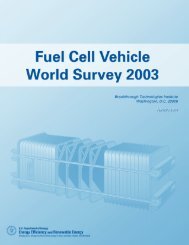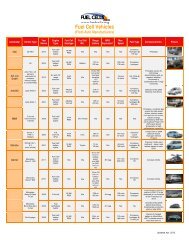Breakthrough Technologies Institute - Fuel Cells 2000
Breakthrough Technologies Institute - Fuel Cells 2000
Breakthrough Technologies Institute - Fuel Cells 2000
You also want an ePaper? Increase the reach of your titles
YUMPU automatically turns print PDFs into web optimized ePapers that Google loves.
Indiana Department of Revenue<br />
100 N Senate Avenue<br />
Indianapolis, IN 46204<br />
Phone: (317) 233-4018<br />
E-mail: tartis@dor.in.gov<br />
Web: www.in.gov/dor<br />
4. INCENTIVES/MARKET STIMULATION<br />
POWER GENERATION<br />
Indiana Clean Energy Credit Program<br />
www.in.gov/idem/air/standard/Sip/guide.pdf<br />
www.in.gov/idem/energycredit<br />
The Indiana Clean Energy Credit Program is a state program that awards “credits” to<br />
companies for voluntary high-efficiency energy projects and renewable energy projects.<br />
Credits can be sold or traded on a national market, with recent credits valued in the<br />
range of $2,500 to $6,000. One credit is awarded for each ton of NOx emissions<br />
prevented.<br />
Any individual, group, organization or business that uses electricity or other forms of<br />
energy or that produces electricity from renewable sources, and can initiate, finance, or<br />
carry out projects that reduce or displace electricity generation or reduce other energy<br />
may become a sponsor for projects that claim credits through the Indiana Clean Energy<br />
Credit Program. Eligible projects include:<br />
• Highly efficient electricity generation for the predominant use of a single end<br />
user, such as combined cycle, CHP, microturbines and fuel cell systems;<br />
• Zero emission renewable energy projects that displace electricity produced<br />
by a utility for the power grid. Projects in this category should involve energy<br />
resources that either cannot be depleted (e.g. wind and sun) or that can be<br />
rapidly replenished (such as biomass) and that do not emit NOx or other<br />
criteria pollutants during their operation. Examples could include<br />
photovoltaics, wind turbines, hydropower or ethanol-powered fuel cells;<br />
• Energy efficiency projects generating electricity through the capture of<br />
methane gas from sanitary landfills, water treatment plants, sewage<br />
treatment plants or anaerobic digestion systems operating on animal and/or<br />
plant wastes; and<br />
• The installation of highly efficient electricity generation equipment for the sale<br />
of power where such equipment replaces or displaces retired electrical<br />
generating units (combined cycle systems, combustion turbines or boilers<br />
serving greater than 25 MW).<br />
In order to be considered as highly efficient electricity generation, fuel cell generating<br />
systems must meet or exceed the following thresholds: fuel cell systems must have a<br />
rated energy efficiency of 40%, whether or not the fuel cell system is part of a CHP<br />
energy system.<br />
82






